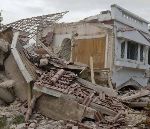Haiti’s Deforestation Epidemic

This September, I traveled with a group of 20 environmental journalists from around the world to attend the World Climate Conference, in Geneva. The international conference was hosted by the World Meteorological Organization (WMO) – sort of a lead-up to Copenhagen. Our group (brought together by a Geneva-based non-profit) was a motley crew – Ido from Israel, Sarah from Denmark, Steve from Canada, Ruediger from Germany, Mariona from France (via Spain), John from Kenya, Aline from Brazil, Ola from the UAE, Jayashri from India… and Colette from Haiti.
If you’ve ever witnessed a group of journalists collected in one room and probing a source on a particular issue about which they feel… concerned… then you can imagine the strained and tense undertone of the questions our group posed to the thinkers and climate leaders with whom we met that week. These were thinkers and leaders who shared our concerns about the climate disasters that are here today and the ones the future will bring, but who were, in some cases, unable to give straight answers. When will the US name a hard and fast carbon reduction goal for itself? How much financial aid will the developed world give to the developing world for climate change adaptation? Will powerful nations facilitate transfers of clean energy technologies to countries that need them? How soon? When? How much?
But when it came to pressing the hard questions, no one in the group was as patiently tenacious as Colette from Haiti – and with good reason. Her small island state has been suffering unspeakable and largely ignored environmental degradation for decades: most of the poor nation relies on charcoal for fuel and food, and fells trees to meet that need. As a result, the nation is 97% deforested, and completely vulnerable to treacherous flooding and mudslides. Rainfalls move unobstructed down treeless mountains and rush into cities like Port-au-Prince.
And then there’s the threat of water coming at Haitians from the other direction, up from the coastline, as sea levels rise with climate change. No one needs to be told that Haiti isn’t prepared to face climate-related challenges like these alone. What about small island nations like Haiti? Colette asked again and again and again that week in Geneva, patient and calm, yet determined to be heard, to make Haiti’s dire environmental situation known. What about poor small island states, the places most vulnerable to climate change?
The answers she got did not seem, on the whole, substantial enough.
This astonishing short bit of reported footage filmed by Brent Renaud for the New York Times just three weeks before the 7.0 earthquake hit discusses the deforestation that plagues Haiti, and gives a good sense of what Colette, an environmental reporter in Haiti, is up against each day. “Relying almost exclusively on charcoal for cooking and heating,” says Renaud in the film, “the Hatian people have literally picked their country apart.”
“Even before the earthquake, deforestation has left Haiti dangerously vulnerable to natural disasters. Floods and mudslides have killed more than 10,000 people in the last four years. The erosion of the soil has crippled agriculture, destroyed much of the natural beauty of the country, and decimated its infrastructure. Roads are washed out faster than they can be rebuilt.”
The Red Cross is now guessing that a third of Haiti’s 9 million people have been displaced by the earthquake, and that thousands are dead. Obama suggests sending donations through the Red Cross, or even tacking a $10 Red Cross relief gift on to your cell phone by texting “HAITI” to 90999.





